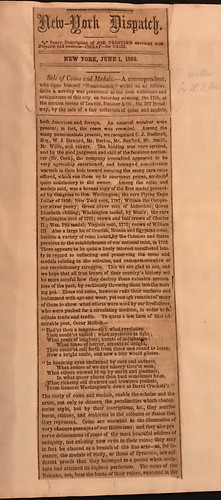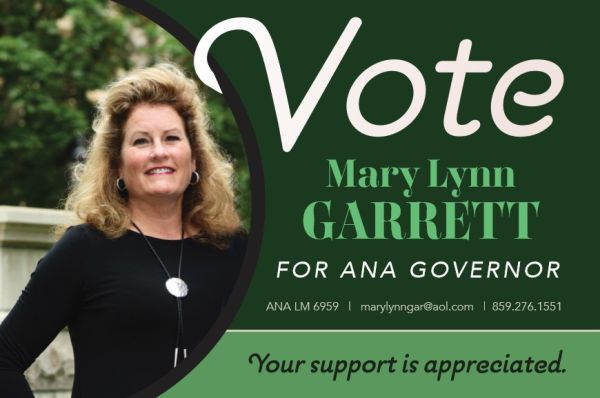
Here's the third of three summaries of articles by Joel Orosz on Bushnell's Compendium Catalog, originally published in our print journal, The Asylum. While The E-Sylum is free to all, only paid members of NBS receive The Asylum. To join, see
https://www.coinbooks.org/about/membership.html
.
This one discusses Winslow Howard.
WINSLOW HOWARD SALE
The article provides information on the life of Winslow J. Howard, a prominent numismatist. He was
born in New Hampshire and began his career with Tiffany & Co. in New York City. Howard became
interested in collecting coins about 1850 and lobbied for the regular production of proof coinage in the
U.S. in 1855. He was an active collector and bidder in auctions in the 1850s, including the 1855 Pierre
Flandin sale and the John W. Kline auction. In 1857, Howard corrected a mistake in a newspaper article
about the "old red cent."
ECSTASY OF EARLY 1858
The text provides a historical account of Winslow J. Howard, an American numismatist, who was among
the first people to print a "wanted to buy" list for old coppers. In 1858, Howard made significant
intellectual contributions to John Hickox's research-based monograph on American coinage and was
visited by Dr. Montroville Wilson Dickeson, who examined his collection to write his landmark American
Numismatical Manual. Howard sold some of his coins to George N. Dana of Boston, including the Non
Dependens Status engraved copper, which he believed to be unique and one of the pattern pieces
engraved and designed by Paul Revere. The other featured coin was the Washington half dollar of 1792,
which Howard found even more fascinating. Charles B. Norton published a feature on these two coins,
along with engravings and descriptions of the coins, in his Norton's Literary Letter No. 2 in 1857.
AGONY OF 1858
In 1858, Winslow Howard was diagnosed with consumption (tuberculosis) and moved to New Mexico
for a drier climate. He spent the next four decades moving from town to town in the Western US,
opening jewelry shops and collecting a variety of precious objects. He married Abbie Stratton in 1865,
but their long-distance relationship and Howard's tuberculosis caused tension and eventually led to
divorce in 1881. Howard also developed an interest in collecting plants and insects, which he displayed
in his shops and sent to interested scientists. Many of his specimens were new to science, but he
received little credit for his discoveries.

The only known portrait of Winslow J. Howard
ITINERANT COLLECTOR
Winslow Howard was a well-known coin hobbyist in the second half of the 19th century, who lived in
New Hampshire and New York. After moving to the mountain West, Howard became one of the few
numismatists in the region. He found ways to keep his hand in the numismatic game by displaying rare
coins from his collection, hanging out his shingle as an assayer, and opening a shop in Denver. In 1882,
he moved to Silver City and experienced a resurgence of his numismatic interest. In 1884 and 1886,
Howard consigned his numismatic collections for auction. The American Journal of Numismatics
reviewed the sales, and Howard's collections contained rare and choice specimens of coins and medals
of Mexico and Spanish American countries.
LONG-LOST HOWARD SALE
The text discusses the Winslow Howard sale of coins and medals that occurred in 1856. The sale was not
a free-standing auction sale catalog and was sold as a tag-on to a catalog of books. The dearth of
information about the collection and the fact that it was sold as an addenda made the sale obscure. The
only evidence of the sale's existence was recorded by Charles Ira Bushnell in 1859, where he recorded
sales of coins and medals at public auctions in New York City. Q. David Bowers noted the obscurity
surrounding the Winslow Howard sale in 1998. Attinelli offers possibilities to consider and notes two
entries cataloged by Leavitt Delisser & Co. The text then discusses the next step of identifying the book
sale catalog that included the addenda. McKay's American Book Auction Catalogues 1714-1934 does not
provide any answers.
 HOWARD SALE, LOST AND FOUND
HOWARD SALE, LOST AND FOUND
The article discusses the history of the Howard addenda, which is a collection of coins that were sold at
a Leavitt Delisser & Co. trade sale of books in New York City on May 17, 1856. The article provides
information on the history of Leavitt Delisser & Co., the advertisement for the trade sale, and the
cataloger of the Winslow Howard sale. It explains why the identification of the Howard sale was elusive
for a long time and provides insight into the auction process during the 19th century.
HOWARD SALE OF MAY 17, 1856
The text describes the May 17, 1856 auction of coins and medals by Leavitt, Delisser & Co., with
particular focus on the addenda that describes lots 196-247. The author compares the original addenda
to the columns clipped from it and pasted into a compendium catalog by a collector named Charles Ira
Bushnell. Bushnell made several annotations, including grading and rarity judgments, that differ from
the catalog. The author provides examples of this with lot 196, a Washington Before Boston medal, and
lots 198 and 204, a Gobrecht dollar and a 1791 Washington Cent. The author also notes that Bushnell
cut the original addenda to size to match his catalog and discarded useful information from the original
in the process.
HOWARD SALE: ORIGINAL ADDENDA AND ATTINELLI REPRINT
The text discusses the Howard sale of coins and medals, held in 1856. The untrimmed original addenda
and a priced unnamed reprint of it, both in the Library of the ANS, provide useful insights about the sale.
The untrimmed addenda reveals that there were four additional unnumbered lots of coins offered, one
printed on the addenda itself and three manuscript lots added in pencil. The total realization of the
three unnumbered manuscript lots, 64 cents, when added to the total return of the addendum's 52
numbered lots, $37.97, yield a total realization of $38.61 for the entire addenda. It is noted that the
proceeds of the 195 lots of books that preceded the sale of Howard's coins were possibly included in the
mix, either added to the $38.61 realized by the numismatic lots or posted instead of the numismatic
realization. The Howard addenda was a hurried emission from a bookseller, not a coin dealer, and was
therefore ephemeral to numismatists from the time of its issue. At some point before the publication of
Numisgraphics in 1876, someone decided to reprint some of the rarities of the American series,
including the Howard addendum, with nominal numbers in excess of the mid-1870s demand.
 BUYERS AT THE HOWARD SALE
BUYERS AT THE HOWARD SALE
The Winslow Howard auction of 1856 was dominated by "Cash" buyers, who paid invoices on a cash-
and-carry basis, while only seven named individuals bought the remaining 14 lots, including "Wilson" or
"Willis," "Hayes" or "Hays," and "Oliver." The identity of "Wilson" or "Willis" and "Hayes" or "Hays"
remains unknown, while "Oliver" is believed to be James Oliver, a founder of the American Numismatic
Society. The buyers of the three manuscript lots in the ANS addenda are "Fish" or "Fisk," "Curtis," and
yet another "Cash." It is also noted that no one was a named buyer in all three sales (Flandin, Groux, and
Howard addenda).
AFTER-SALE REPORT
The article discusses the auction of Winslow J. Howard's coin collection, which was held in May 1856.
The article reports on a clipping from the New-York Dispatch which was printed two weeks after the
sale. The summary begins factually but quickly turns promotional, written by Howard himself. The article
criticizes Howard's sales report as a bit over the top, as the prices realized in the auction were middling
and not enormous. The article concludes with Howard's philosophical rumination on the cultural value
of coin collecting.
To read the earlier E-Sylum articles, see:
BUSHNELL'S COMPENDIUM CATALOG, PART ONE
(https://www.coinbooks.org/v26/esylum_v26n17a07.html)
BUSHNELL'S COMPENDIUM CATALOG, PART TWO
(https://www.coinbooks.org/v26/esylum_v26n18a13.html)
Wayne Homren, Editor
The Numismatic Bibliomania Society is a non-profit organization
promoting numismatic literature. See our web site at coinbooks.org.
To submit items for publication in The E-Sylum, write to the Editor
at this address: whomren@gmail.com
To subscribe go to: https://my.binhost.com/lists/listinfo/esylum
Copyright © 1998 - 2024 The Numismatic Bibliomania Society (NBS)
All Rights Reserved.
NBS Home Page
Contact the NBS webmaster
|






